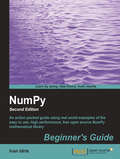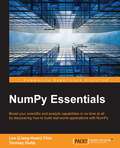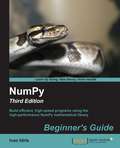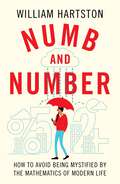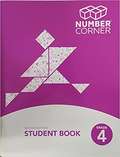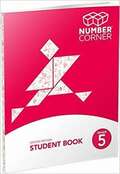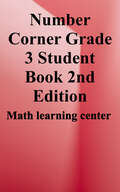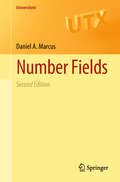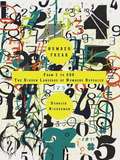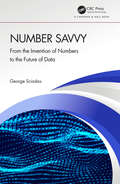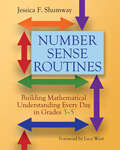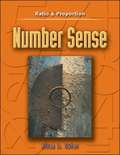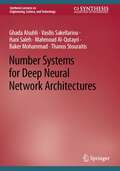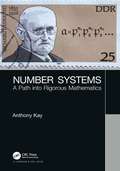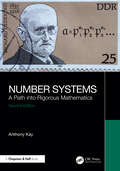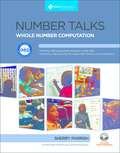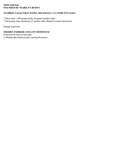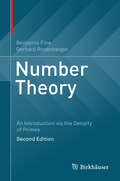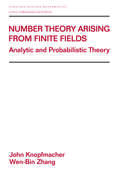- Table View
- List View
NumPy Beginner's Guide (Second Edition)
by Ivan IdrisThe book is written in beginner's guide style with each aspect of NumPy demonstrated with real world examples and required screenshots.If you are a programmer, scientist, or engineer who has basic Python knowledge and would like to be able to do numerical computations with Python, this book is for you. No prior knowledge of NumPy is required.
NumPy Essentials
by Tanmay Dutta Leo Liang-Huan ChinBoost your scientific and analytic capabilities in no time at all by discovering how to build real-world applications with NumPy About This Book * Optimize your Python scripts with powerful NumPy modules * Explore the vast opportunities to build outstanding scientific/ analytical modules by yourself * Packed with rich examples to help you master NumPy arrays and universal functions Who This Book Is For If you are an experienced Python developer who intends to drive your numerical and scientific applications with NumPy, this book is for you. Prior experience or knowledge of working with the Python language is required. What You Will Learn * Manipulate the key attributes and universal functions of NumPy * Utilize matrix and mathematical computation using linear algebra modules * Implement regression and curve fitting for models * Perform time frequency / spectral density analysis using the Fourier Transform modules * Collate with the distutils and setuptools modules used by other Python libraries * Establish Cython with NumPy arrays * Write extension modules for NumPy code using the C API * Build sophisticated data structures using NumPy array with libraries such as Panda and Scikits In Detail In today's world of science and technology, it's all about speed and flexibility. When it comes to scientific computing, NumPy tops the list. NumPy gives you both the speed and high productivity you need. This book will walk you through NumPy using clear, step-by-step examples and just the right amount of theory. We will guide you through wider applications of NumPy in scientific computing and will then focus on the fundamentals of NumPy, including array objects, functions, and matrices, each of them explained with practical examples. You will then learn about different NumPy modules while performing mathematical operations such as calculating the Fourier Transform; solving linear systems of equations, interpolation, extrapolation, regression, and curve fitting; and evaluating integrals and derivatives. We will also introduce you to using Cython with NumPy arrays and writing extension modules for NumPy code using the C API. This book will give you exposure to the vast NumPy library and help you build efficient, high-speed programs using a wide range of mathematical features. Style and approach This quick guide will help you get to grips with the nitty-gritties of NumPy using with practical programming examples. Each topic is explained in both theoretical and practical ways with hands-on examples providing you efficient way of learning and adequate knowledge to support your professional work.
NumPy: Beginner's Guide - Third Edition
by Ivan IdrisThis book is for the scientists, engineers, programmers, or analysts looking for a high-quality, open source mathematical library. Knowledge of Python is assumed. Also, some affinity, or at least interest, in mathematics and statistics is required. However, I have provided brief explanations and pointers to learning resources.
Numb and Number: How to Avoid Being Mystified by the Mathematics of Modern Life
by William HartstonLike it or not, our lives are dominated by mathematics. Our daily diet of news regales us with statistical forecasts, opinion polls, risk assessments, inflation figures, weather and climate predictions and all sorts of political decisions and advice backed up by supposedly accurate numbers. Most of us do not even pause and question such figures even to ask what they really mean and whether they raise more questions than they answer. We let the figures wash over us with no more than a glance. In this simple guide for anyone numbed by numbers, William Hartston explains with clarity and humor how to steer a safe path through the minefield of mathematics that surrounds us.
Numbed!
by David LubarWhen Logan’s class takes a trip to a math museum, his mischievous friend Benedict is sure it will be a boring day—until he discovers a robot and its creator in an off-limits area. The robot proves feisty, and soon both boys get zapped. They realize only later that they’d left the museum without their math skills. To get back the knowledge they need for school—not to mention buying food at the mall, divvying up dinner at home, and much more—they’ll have to get back to the museum and pass a series of math challenges. Being “numbed” teaches Logan and Benedict just how useful, and even fun, math can be.
Number Activities For Early Learners: Ideas for Parents and Pre-School Teachers
by Jan ConaglenThis e-book outlines interesting and age appropriate activities that can be carried out by parents and preschool teachers. It uses concrete materials so young children can visualize concepts, predict outcomes and display confidence, whilst learning from the suggested tasks.It will provide parents and preschool teachers with an insight into the importance of early basic mathematical knowledge.It will help develop the understanding and application of more complex skills that the student requires for later learning.The activities suggested are suitable for 3 years - 6 years old. This is usually preschool children up to second year at school.
Number Corner Second Edition Grade 5 Student Book
by The Math Learning CenterA mathematics textbook
Number Corner, Grade 2, Student Book, Spanish Edition
by The Math Learning CenterNIMAC-sourced textbook
Number Corner: Student Book
by Math Learning CenterThe Number Corner 2nd Edition Grade 3 Student Book provides students with opportunities to solve problems, conduct investigations, and practice skills in the context of familiar Number Corner Grade 3 lessons.
Number Fields (Universitext)
by Daniel A. MarcusRequiring no more than a basic knowledge of abstract algebra, this text presents the mathematics of number fields in a straightforward, pedestrian manner. It therefore avoids local methods and presents proofs in a way that highlights the important parts of the arguments. Readers are assumed to be able to fill in the details, which in many places are left as exercises.
Number Freak
by Derrick NiedermanNumber fanatic Derrick Niederman has a mission - to bring numbers to life. In Number Freak he explores the unique properties of the most fascinating numbers from 1 to 200, wherever they may crop up: from mathematics to sport, from history to the natural world, from language to pop culture. Packed with illustrations, amusing facts, puzzles, brainteasers and anecdotes, Number Freak is an enthralling and thought-provoking numerical voyage through the history of mathematics, investigating problems of logic, geometry and arithmetic along the way. Entertaining and accessible, it is a must for trivia addicts, maths-lovers and arithmophiles.
Number One Puppy
by Zachary WilsonA story about a little girl going to a dog pound to choose a pet.
Number Properties GRE Math Strategy Guide 2nd Edition
by Manhattan Gre StaffUpdated for the revised GRE, the Number Properties Guide provides a comprehensive analysis of the properties and rules of integers tested on the GRE to help you learn, practice, and master everything from prime products to perfect squares. Each chapter builds comprehensive content understanding by providing rules, strategies and in-depth examples of how the GRE tests a given topic and how you can respond accurately and quickly. The Guide contains both "Check Your Skills" questions in the chapters that test your understanding as you go and "In-Action" problems of increasing difficulty, all with detailed answer explanations.
Number Savvy: From the Invention of Numbers to the Future of Data
by George SciadasThis book is written for the love of numbers. It tells their story, shows how they were invented and used to quantify our world, and explains what quantitative data mean for our lives. It aspires to contribute to overall numeracy through a tour de force presentation of the production, use, and evolution of data. Understanding our physical world, our economies, and our societies through quantification has been a persistent feature of human evolution. This book starts with a narrative on why and how our ancestors were driven to the invention of number, which is then traced to the eventual arrival at our number system. This is followed by a discussion of how numbers were used for counting, how they enabled the measurement of physical quantities, and how they led to the estimation of man-made and abstract notions in the socio-economic domain. As data don’t fall like manna from the sky, a unique feature of this book is that it explains from a teacher’s perspective how they’re really conceived in our minds, how they’re actually produced from individual observations, and how this defines their meaning and interpretation. It discusses the significance of standards, the use of taxonomies, and clarifies a series of misconceptions regarding the making of data. The book then describes the switch to a new research paradigm and its implications, highlights the arrival of microdata, illustrates analytical uses of data, and closes with a look at the future of data and our own role in it.
Number Sense Routines: Building Mathematical Understanding Every Day in Grades 3-5
by Jessica ShumwayFollowing up her' best-selling book, Number Sense Routines: Building Numerical Literacy Every Day in Grades K-3, Jessica Shumway turns her focus to upper elementary classrooms. Number Sense Routines: Developing Mathematical Understanding Every Day in Grades 3-5 is about tapping into every child' s innate number sense and providing daily, connected experiences that are responsive to children's learning needs. Consistent, Daily Routines Work:' Adaptable to any curriculum, Shumway' s 5, 10, or 15 minute warm-up routines are an easy and effective way to build and solidify students' number sense foundations as a supplement to any program Planning and Facilitating Your Classroom:' No matter how familiar the routine, Shumway provides insight on how to keep daily warm-ups fresh. She reveals careful thinking and planning that goes into each routine and offers detailed vignettes and dialogues of how they unfold in real classrooms Assessment Strategies:' As students engage in the process, each routine becomes an exciting opportunity to gain insight into where they are in their understanding and help students articulate their mathematical thinking Identify Big Ideas: Not only will these math routines help develop students' mathematical understanding as they move towards using standard algorithms, but teachers will learn to better recognize the big ideas that emerge in discussions, how to encourage important strategies based in number sense, and how to facilitate conversations on key mathematical concepts. ' 'These routines may appear in other places, [but] I have never seen them written in such detail and with so many variations.. . .. Although she makes what she does sound easy, we all know that teaching math well is anything but easy. It is challenging and complex. Unpacking what students are saying, helping them make connections not only to the math but to each other's ideas, while simultaneously recording their ideas using mathematical models, visuals, or equations is no easy task. Jessica provides wonderful visuals, examples of student work, and so much more to help educators develop the tools they need to improve their practice and in so doing improve student learning. ' ' ' ' ' ' ' ' ' ' ' ' ' ' ' ' ' ' ' ' ' ' ' ' ' ' ' ' ' ' ' ' ' ' ' ' ' ' ' ' ' ' ' ' ' ' ' ' ' ' ' ' ' ' ' ' ' ' ' ' ' ' ' ' ' ' ' ' ' ' ' ' ' ' ' ' ' ' ' ' ' ' ' ' ' ' ' ' ' ' ' ' ' ' ' ' ' ' ' ' ' ' ' ' ' ' ' ' ' ' ' ' ' ' ' ' ' ' ' ' ' – From the Foreword by math coach and consultant Lucy West
Number Sense and Nonsense: Building Math Creativity and Confidence Through Number Play
by Claudia ZaslavskyThese 80-plus math activities and number games help kids to think critically about math instead of just memorizing rules. The emphasis is on the underlying relationships between numbers and the process of manipulating them. Kids get together and play games with odd and even numbers, prime and composite numbers, factors, divisors, and multiples of numbers, common and decimal fractions. Children learn the history of numbers--finger counting, number symbols in various cultures, and different ways of calculating. The book is full of riddles, puzzles, number tricks, and calculator games. Kids develop skills in estimation and computation as they become familiar with the characteristics and behavior of numbers. They will gain math confidence and be ready to take chances, find their own errors, and challenge their peers.
Number Sense: Percent Applications
by Allan SuterContemporary's popular Number Sense mathematics series has been updated! Number Sense encourages students to explore number relationships to build a concrete understanding of mathematical operations, problem-solving strategies, and real-life applications. Each text uses a highly visual and active approach to introduce basic mathematics concepts. Each lesson is carefully designed to simultaneously build students' mastery and self-confidence. Each text illustrates a basic math skill with a step-by-step approach, and follows with lots of practice.
Number Systems for Deep Neural Network Architectures (Synthesis Lectures on Engineering, Science, and Technology)
by Baker Mohammad Hani Saleh Thanos Stouraitis Ghada Alsuhli Vasilis Sakellariou Mahmoud Al-QutayriThis book provides readers a comprehensive introduction to alternative number systems for more efficient representations of Deep Neural Network (DNN) data. Various number systems (conventional/unconventional) exploited for DNNs are discussed, including Floating Point (FP), Fixed Point (FXP), Logarithmic Number System (LNS), Residue Number System (RNS), Block Floating Point Number System (BFP), Dynamic Fixed-Point Number System (DFXP) and Posit Number System (PNS). The authors explore the impact of these number systems on the performance and hardware design of DNNs, highlighting the challenges associated with each number system and various solutions that are proposed for addressing them.
Number Systems: A Path into Rigorous Mathematics
by Anthony KayNumber Systems: A Path into Rigorous Mathematics aims to introduce number systems to an undergraduate audience in a way that emphasises the importance of rigour, and with a focus on providing detailed but accessible explanations of theorems and their proofs. The book continually seeks to build upon students' intuitive ideas of how numbers and arithmetic work, and to guide them towards the means to embed this natural understanding into a more structured framework of understanding. The author’s motivation for writing this book is that most previous texts, which have complete coverage of the subject, have not provided the level of explanation needed for first-year students. On the other hand, those that do give good explanations tend to focus broadly on Foundations or Analysis and provide incomplete coverage of Number Systems. Features Approachable for students who have not yet studied mathematics beyond school Does not merely present definitions, theorems and proofs, but also motivates them in terms of intuitive knowledge and discusses methods of proof Draws attention to connections with other areas of mathematics Plenty of exercises for students, both straightforward problems and more in-depth investigations Introduces many concepts that are required in more advanced topics in mathematics.
Number Systems: A Path into Rigorous Mathematics
by Anthony KayNumber Systems: A Path into Rigorous Mathematics aims to introduce number systems to an undergraduate audience in a way that emphasises the importance of rigour, and with a focus on providing detailed but accessible explanations of theorems and their proofs.The book continually seeks to build upon students' intuitive ideas of how numbers and arithmetic work, and to guide them towards the means to embed this natural understanding into a more structured framework of understanding. The author’s motivation for writing this book is that most previous texts, which have complete coverage of the subject, have not provided the level of explanation needed for first-year students. On the other hand, those that do give good explanations tend to focus broadly on Foundations or Analysis and provide incomplete coverage of Number Systems.Features Approachable for first year undergraduates, but still of interest to more advanced students and postgraduates Does not merely present definitions, theorems and proofs, but also motivates them in terms of intuitive knowledge and discusses methods of proof Draws attention to connections with other areas of mathematics Plenty of exercises for students, both straightforward problems and more in-depth investigations Introduces many concepts that are required in more advanced topics in mathematics New to the second edition Complete solutions to all exercises, and hints for the in-depth investigations Extensive changes to chapters 4 and 5, including defining integral domains as distinct from commutative rings, a more complete discussion of irreducibles, primes and unique factorisation, and more topics in elementary number theory A completely revised chapter 8, giving a more coherent account of quadratic rings and their unique (or non-unique) factorisation properties A thorough correction of typos and errors across all chapters Updates to the bibliography
Number Talks, Grades K-5: Helping Children Build Mental Math and Computation Strategies
by Sherry ParrishNumber Talks A five- to fifteen-minute classroom conversation around purposefully crafted computation problems that are solved mentally. The best part of a teacher's day. This dynamic multimedia resource was created in response to the requests of teachers--those who want to implement number talks but are unsure of how to begin and those with experience who want more guidance in crafting purposeful problems. It supports teachers in understanding: what a classroom talk is; how to follow students' thinking and pose the right questions to build understanding; how to prepare for and design purposeful number talks; and how to develop grade-level-specific strategies for the operations of addition, subtraction, multiplication, and division. Number Talks supports the Common Core State Standards for Mathematics.
Number Talks: A Multimedia Professional Learning Resource
by Sherry Parrish Ann DominickNumber Talks 1. A five- to fifteen-minute classroom conversation around purposefully crafted problems that are solved mentally. 2. The best part of a teacher’s day. <p><p>This dynamic multimedia resource was created in response to the requests of teachers—those who want to implement number talks but are unsure of how to begin and those with experience who want more guidance in crafting purposeful problems. It supports teachers in understanding: <p><p>• what a classroom number talk is; <p><p>• how to follow students’ thinking and pose the right questions to build understanding; <p><p>• how to prepare for and design purposeful number talks; and <p><p>• how to develop fractional reasoning and strategies for operating with fractions, decimals, and percentages.
Number Theory
by Benjamin Fine Gerhard RosenbergerNumber theory is fascinating. Results about numbers often appear magical, both in theirstatementsandintheeleganceoftheirproofs. Nowhereisthismoreevidentthan inresultsaboutthesetofprimenumbers. Theprimenumbertheorem, whichgivesthe asymptotic density of the prime numbers, is often cited as the most surprising result in all of mathematics. It certainly is the result that is hardest to justify intuitively. The prime numbers form the cornerstone of the theory of numbers. Many, if not most, results in number theory proceed by considering the case of primes and then pasting the result together for all integers using the fundamental theorem of arithmetic. The purpose of this book is to give an introduction and overview of number theory based on the central theme of the sequence of primes. The richness of this somewhat unique approach becomes clear once one realizes how much number theoryandmathematicsingeneralareneededinordertolearnandtrulyunderstandthe prime numbers. Our approach provides a solid background in the standard material as well as presenting an overview of the whole discipline. All the essential topics are covered: fundamental theorem of arithmetic, theory of congruences, quadratic reciprocity, arithmetic functions, the distribution of primes. In addition, there are ?rm introductions to analytic number theory, primality testing and cryptography, and algebraic number theory as well as many interesting side topics. Full treatments and proofs are given to both Dirichlet s theorem and the prime number theorem. There is acompleteexplanationofthenewAKSalgorithm, whichshowsthatprimalitytesting is of polynomial time. In algebraic number theory there is a complete presentation of primes and prime factorizations in algebraic number ?elds. "
Number Theory Arising From Finite Fields: Analytic And Probabilistic Theory
by John Knopfmacher Wen-Bin Zhang"Number Theory Arising from Finite Fields: Analytic and Probabilistic Theory" offers a discussion of the advances and developments in the field of number theory arising from finite fields. It emphasizes mean-value theorems of multiplicative functions, the theory of additive formulations, and the normal distribution of values from additive functions
